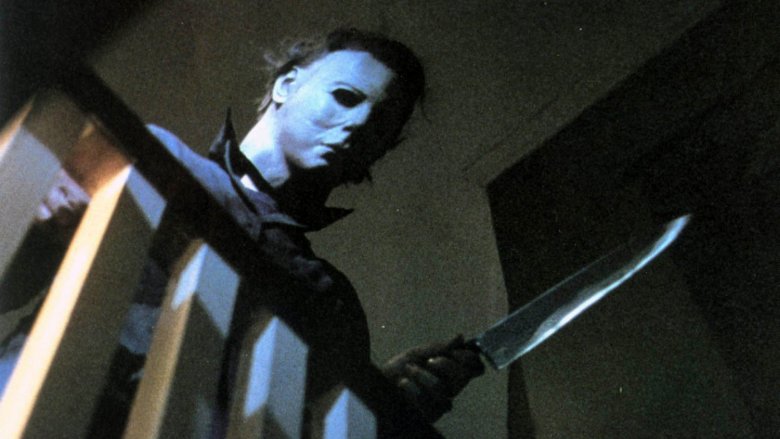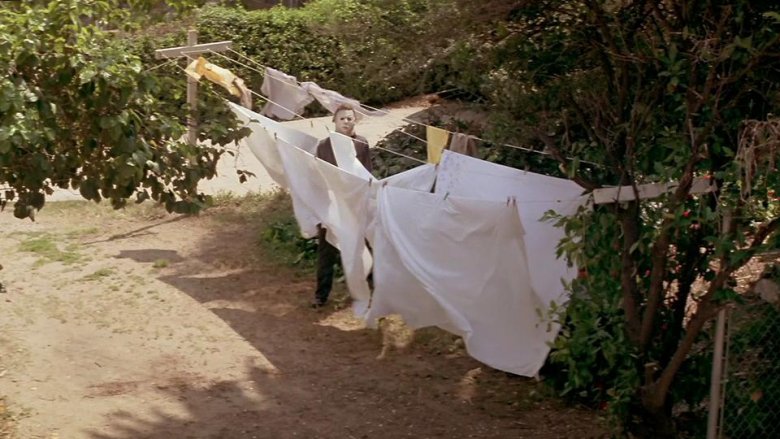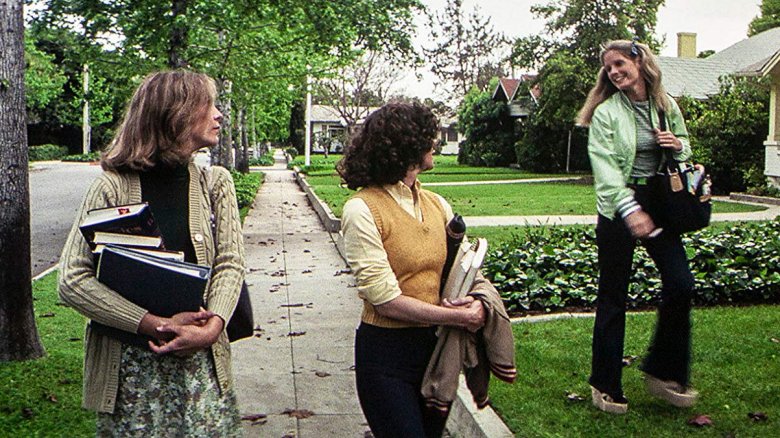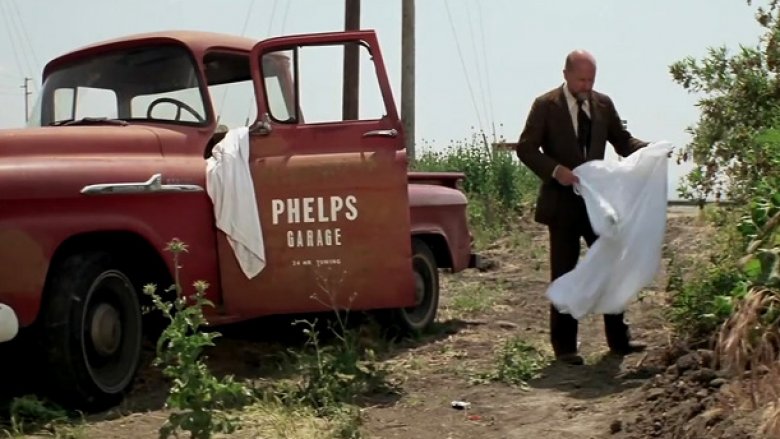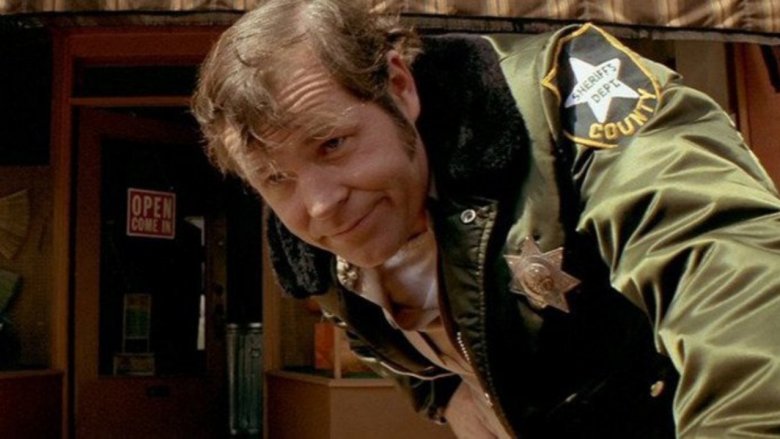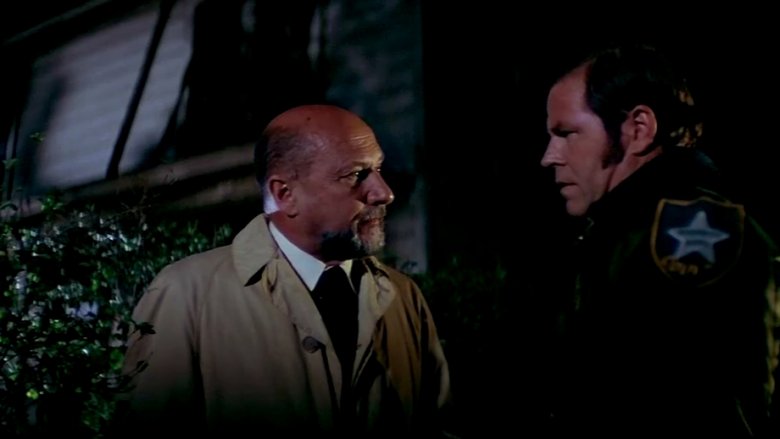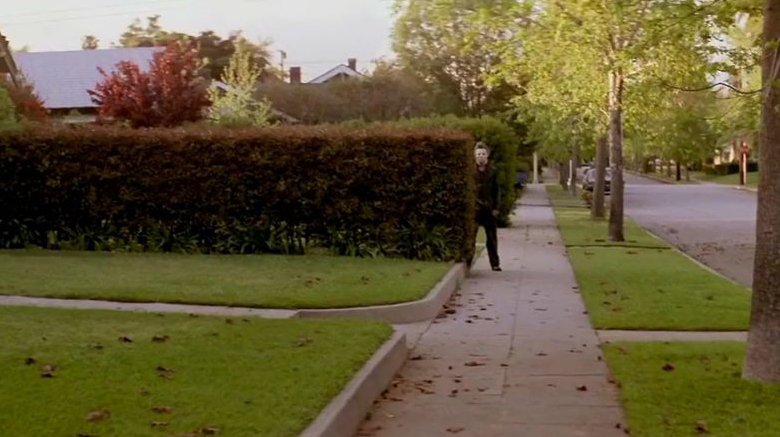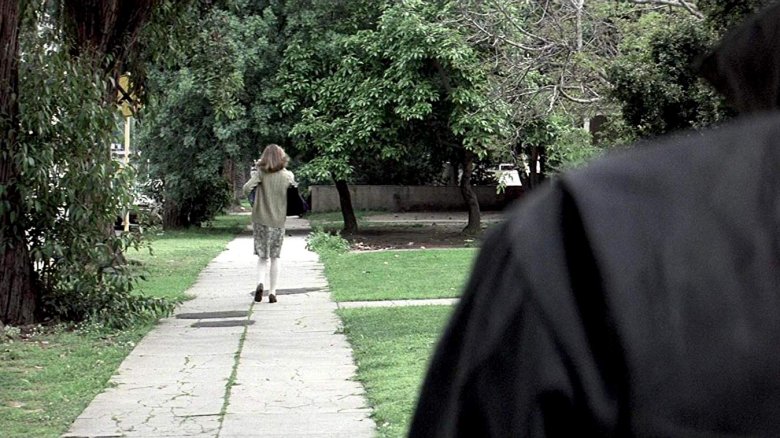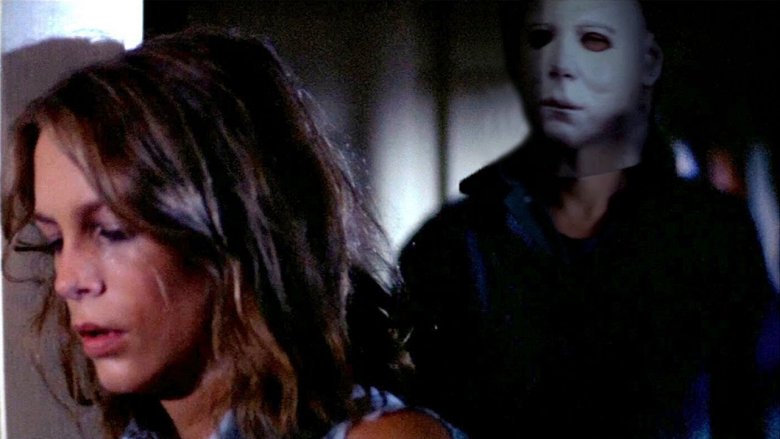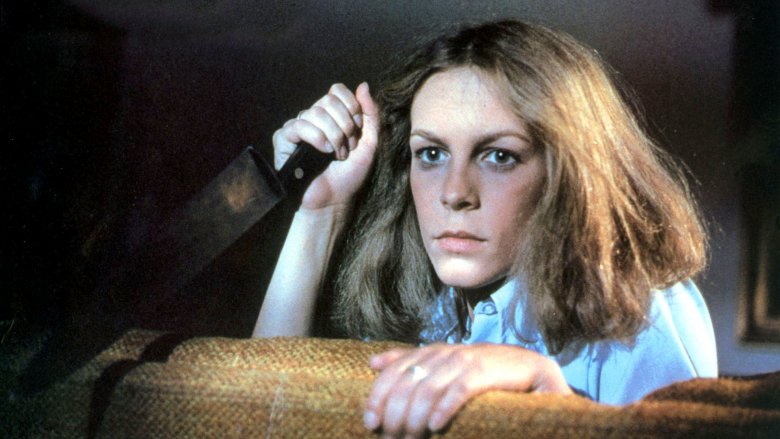Dumb Things In The Original Halloween Everyone Ignores
John Carpenter's Halloween is a horror masterpiece that helped to popularize the slasher genre among mainstream audiences. The silent masked serial killer Michael Myers has captivated and horrified audiences since his 1978 debut, and will doubtless continue to do so in the upcoming Halloween sequels. Without Michael, we would have likely never seen the likes of Jason Voorhees or Freddy Kruger.
Halloween may be best known for creating one of the most iconic slasher villains, but it also crystallized both the final girl and scream queen tropes. It's also just a well-crafted film — the film's opening sequence in particular is still celebrated for its (at the time) uniquely chilling cinematography. With all of these achievements in mind, it's no wonder why horror fans continue to enjoy the Carpenter classic to this day.
Though Halloween is renowned among horror hounds, the film is not without its flaws, oddities, and strange leaps of logic. None of these examples can diminish the film's overall legacy, but let's not pretend there aren't some dumb things everyone ignores about John Carpenter's Halloween.
Michael can teleport
Michael Myers is one of the most terrifying slasher villains in horror history. The masked killer attacks without a motive, and can appear and disappear with relative ease. You never know when or where Michael will pop up, but rest assured, once he has his sights on a victim, he will do whatever it takes to hunt them down.
However, some aspects of Michael's character are wildly unrealistic. To be more specific, the killer's ability to transport instantly from location to location is just a little bit silly.
The best example of Michael's apparent superpower is when Laurie spots him outside of her window. Though Carpenter cuts to a reaction shot from Laurie, at no point does she break eye-contact with Michael. Yet somehow, when the shot switches back to show Michael, he's gone. Based on Laurie's reaction, Michael must have disappeared. Since Laurie was watching him, there is no way she wouldn't have seen Michael wander off between shots.
In another example, Michael pursues Laurie to the Doyle house. Laurie secures herself only a few feet away from the front door she just came through. Somehow, Michael jumps out from behind Laurie as if he has been positioned there since before she entered the home. Unless he suddenly turned into the Flash, how exactly did Michael get inside before Laurie? Based on the angle, he couldn't have gone through the door or window, so Michael must have just... warped inside.
The high school characters are clearly adults
Horror films of the 1970s hardly ever cast minors to play leading roles. Some of the only notable exceptions are the 1976 classic The Omen or the lesser-known film of the same year that starred a 14-year-old Jodie Foster, The Little Girl Who Lives Down the Lane. For the most part, other major horror films of the decade like Carrie and Last House on the Left tended to cast 20-somethings in the roles of teens. In this respect, Halloween is no different, but that doesn't make the casting any less distracting.
With the exception of Jamie Lee Curtis, who was 19 by the time Halloween was released, the actors who played the teenagers were all well into their twenties. P.J. Soles, the actress who plays Laurie's cheerleader friend Lynda, was 28 years old. Similarly, Laurie's other friend Annie was portrayed by 29-year-old Nancy Keyes. When all three girls are together on screen, it's incredibly awkward watching two grown women pretending to be high school girls. When paired with Curtis, who is noticeably younger than the other two actresses, the glaring age differences are impossible to ignore.
Loomis has a sixth sense
After Michael breaks out of Smith's Grove sanitarium at the beginning of the film, Dr. Loomis rightfully fears what Michael will do with his newfound freedom. He takes his concerns to the police, but is promptly brushed off, leaving Loomis to hunt Michael on his own.
Suspecting Michael will return to his childhood home, Loomis makes his way to Haddonfield. On his way, he stops at a payphone and by pure circumstance, stumbles onto an abandoned car. While the camera pans to show the audience the driver's body lying nearby, Loomis is not privy to the murder. Nevertheless, the good doctor somehow surmises that the abandoned car and a stray matchbook are solid proof that Michael Myers was there.
What's so bizarre about this scene isn't just the unlikely circumstances or Loomis' apparent sixth sense, but the fact that he doesn't appear to report the crime at all. If Loomis is genuinely concerned about what he found, why wouldn't he call the police? If he had taken even a minute to look around and not run off after finding a random matchbook on the ground, he would have seen the dead body. If the police doubted Michael's capabilities before, a murder victim would have likely forced the police to cooperate with Loomis.
The robbery timeline makes no sense
When Annie and Laurie stumble onto a recently robbed hardware store, Annie's father tells them that someone has just stolen a Halloween mask, some knives, and rope. The robbery must have just happened, as the alarm is blaring in the background, and a group of police officers are actively surveying the scene. Given the context, the film is hinting that Michael is the one who stole the mask and the murder tools. In theory, this makes sense, but given the fact that the girls had already encountered a masked Michael far before the robbery supposedly occurred, he couldn't have stolen the mask.
The first time we see Michael after he escapes is when he waits outside Laurie's school. During this appearance, Michael is clearly already wearing the mask. Hours later, when Laurie walks home with her friends, the group encounters Michael on two separate occasions, both times wearing the mask. Right before Laurie goes out with Annie, she spots the masked man again outside of her window. All of these occurrences happen throughout the day before Michael supposedly robs the store. With this in mind, how exactly could he have gotten his hands on the mask beforehand? Unless he robbed another store and took another identical mask for good measure, this timeline just doesn't add up.
Loomis and the sheriff hunt Michael alone
From the very start of the film, Loomis warns everyone he comes into contact with about Michael Myers. For 15 years, Loomis studied and worked with Michael alone. While we don't know much about the specific events that triggered Loomis' immense fear of Michael, it's safe to say the doctor knows far more about the killer's violent tendencies than anyone else. After breaking out of confinement, stealing a car, assaulting a woman, and murdering an innocent man, you'd think anyone hunting Michael would be cautious at the very least.
Surprisingly, the hunt for Michael is incredibly low-key. Loomis seeks out the help of Haddonfield's sheriff, Leigh Brackett, and the two hunt Michael alone. The pair temporarily camp out at Michael's childhood home under the assumption he may return. As the hours roll by, the two don't question what Michael is doing while they sit around and halfheartedly patrol the streets. The sheriff even suggests a full-blown man-hunt at one point, but Loomis tosses the idea aside for fear of causing a panic. Meanwhile, Michael is walking around, killing teenagers and terrorizing Laurie.
It seems hypocritical from Loomis of all people to prefer discretion over action. At the beginning of the film, Loomis was desperately seeking police help, but when he finally gets it, he turns the offer down. If a full search was organized, maybe Laurie's friends wouldn't have been butchered.
Haddonfield is obviously not in Illinois
Halloween is set in the fictional town of Haddonfield, Illinois. However, the film wasn't shot in the Midwest, but instead in sunny California. This isn't necessarily an issue, but it's pretty apparent to most viewers that Haddonfield resembles the west coast more than the Midwest.
The biggest giveaway is probably the mountains in the background. Anyone who has been to Illinois can tell you that mountains aren't exactly a staple of the local geography. The mountains aren't the only background scenery to give away the location. When Laurie walks to school, you can see some small palm trees in the background, an arboreal feature absent from most, if not all, Illinois front lawns.
Outside of the west coast imagery, some other small examples point to the film being shot in California. Both Laurie and Tommy's schools have outdoor lockers. These types of fixtures are not common in regions where students have to contend with ice and snow during the winter months.
Another small piece of California sneaks into the film when Lynda and Tommy arrive at Lindsey's house. As they walk inside, the van in the background features a California license plate. Though it is possible the the car's owner happened to move to Haddonfield from California, it's far more likely that the crew forgot to change out the license plate before filming.
Lori isn't that worried about a stalker
After Laurie first spots Michael at school, they have a few more run-ins before his Halloween killing spree. When walking home with Annie and Lynda, Michael drives past them, with his mask clearly identifiable. Moments later, he steps out from behind a hedge to stare at Laurie. At this point, Laurie is visibly shaken, but she is convinced by her friends that her mind is playing tricks on her.
Laurie again encounters Michael outside of her bedroom window. By this point, Michael is clearly fixating on her, yet Laurie still manages to go on with her day, rather than locking her doors, calling the police, and cancelling her Halloween night babysitting gig. It's even stranger that after all this, she ignores the warnings of her sitting charge, Tommy, accusing him of lying when he desperately tries to convince her that "The Boogeyman" is prowling their neighborhood. By this point, Laurie has seen Michael for herself, so you wouldn't think her first instinct would be to brush it off as a prank.
All in all, it just seems a little odd for a teenage girl to have multiple run-ins with an imposing masked man and not feel threatened enough to do something about it.
Laurie doesn't check to see if Michael is dead
Though it's understandable that Laurie would make some mistakes in a life or death situation, it's less acceptable that she would make the same mistake three times.
When Michael surprises Laurie from inside the Doyle house, she reflexively stabs the killer with a knitting needle. Michael falls to the ground, seemingly defeated. In typical horror fashion, Michael is very much alive and pursues Laurie again shortly after. Again, Laurie attacks Michael, jabbing him in the eye with a coat hanger and stabbing him with a knife. Michael is down once more, but instead of checking to see if he's done for good, Laurie makes the same mistake as before and assumes Michael is dead.
Not ready to call it quits, Michael gets right back up. This time, Loomis takes the offensive and shoots Michael, causing him to fall off of the balcony. Despite Laurie failing to kill Michael twice before, she and Loomis decide it's better to have a conversation rather than to check to make sure the fall or the gunshots successfully killed Michael. By the time anyone bothers to look, Michael is long gone.
If Loomis or Laurie had cared enough to check Michael's pulse, they wouldn't have had to worry about him continuing his killing spree. More importantly, we could have avoided the excessive number of Halloween sequels.
Continuity errors and filming mistakes
Being a low budget independent film created in a short period, Halloween naturally couldn't avoid its fair share of little mistakes, ranging from continuity errors to production goofs. For instance, when Michael first escapes, he is wearing a stark white hospital gown. However, when Michael smashes his hand through a car window and attacks a nurse moments later, he's wearing a different outfit with an orange sleeve.
There are a few more filming mistakes for eagle-eyed viewers to catch. A crew member is reflected in the phone booth glass right before Loomis discovers the driver Michael killed on his way to Haddonfield. Though it can be a bit hard to notice, you can see Lynda stumble as she and Bob head upstairs in the Wallace house. Apparently, P.J. Soles didn't just lose her footing; the actress tripped over a dolly track.
Finally, when Annie is teasing Laurie about Michael in front of the hedges, a puff of smoke is briefly caught on camera. According to John Carpenter in the film's audio commentary, the smoke came from his own cigarette.
While many of these mistakes could have been corrected through editing or reshoots, budget and time constraints made things a bit more complicated. In the end, the crew had to work with what they had. While these examples don't majorly detract from the film's overall quality, they provide a bit of levity in an otherwise horrifying slasher.
